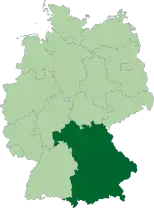| Bezirksoberliga Bayern |
|---|
| Founded |
| 1988 |
| Disbanded |
| 2012 |
| Nation |
 |
| State |
| Promotion To |
| Landesliga Bayern |
| Relegation To |
| Bezirksligas |
| Number of leagues |
| 7 |
| Level on Pyramid |
| Level 7 |
The seven Bezirksoberligas Bayern were the third highest level of the Bavarian football league system, below the Bayernliga and the Landesliga Bayern from 1988 to 2012. They were the seventh tier of the German football league system. Until the introduction of the 3. Liga in 2008 it was the sixth tier of the league system, until the introduction of the Regionalligas in 1994 the fifth tier.
Overview
The seven Bezirksoberligas were introduced in 1988 to create a highest single-division playing level for each of the seven Bezirke. Before that the Bezirksligas were located right below the Landesliga in the pyramid. They were created upon suggestion of the 1. FC Sonthofen.[1] However, it took this club till 1998 to gain promotion to the Bezirksoberliga Schwaben.
The winners of the seven Bezirksoberligas are automatically promoted to their respective Landesliga. The second-placed teams face a series of play-off matches to determine one or two more promotion spots.
Teams relegated from the Bezirksoberliga drop into the Bezirksliga of which there are usually two, except Oberbayern where there are three.
Only one club has won a Bezirksoberliga four times, the TSV Kottern from Schwaben.
The German term "Bezirksoberliga" is best translated as "County Premier League". The Bezirke are political and administrative units similar to a county in size.
With the league reform at the end of the 2011–12 season, which includes an expansion of the number of Landesligas from three to five, the Bezirksoberligas were disbanded. Instead, the Bezirksligas took the place of the Bezirksoberligas below the Landesligas once more.[2]
The clubs from the Bezirksoberligas joined the following leagues:[3]
- Champions: Promotion round to the Bayernliga, winners to the Bayernliga, losers to the Landesliga.
- Teams placed 2nd to 6th: Directly qualified to the Landesliga.
- Teams placed 7th or worse: Between two and six additional Landesliga places, according to the size of the Bezirk, to be determined in a play-off round with the Bezirksliga champions. Non-qualified teams to remain at this tier.
The Bezirk of Upper Bavaria received six additional qualification spots to the Landesliga, Middle Franconia and Lower Franconia received four each, Swabia, Upper Franconia and Lower Bavaria received three, while the Upper Palatinate received only two.[3]
Relation of Bezirksoberligas to Landesligas
- Bezirksoberliga Schwaben - Landesliga Bayern-Süd
- Bezirksoberliga Oberbayern - Landesliga Bayern-Süd
- Bezirksoberliga Mittelfranken - Landesliga Bayern-Mitte
- Bezirksoberliga Oberpfalz - Landesliga Bayern-Mitte
- Bezirksoberliga Niederbayern - Landesliga Bayern-Mitte
- Bezirksoberliga Unterfranken - Landesliga Bayern-Nord
- Bezirksoberliga Oberfranken - Landesliga Bayern-Nord
League statistics
The league's statistics:[4]
Longest-serving clubs
The following clubs have spent more than half of the 24 seasons of the league's existence in it:
| League | Club |
| Bezirksoberliga Schwaben | SpVgg Kaufbeuren (22), TSV Bobingen (16), TSV Kottern (15), TSV 1861 Nördlingen (14), FC Memmingen II (14), TSV Landsberg (13) |
| Bezirksoberliga Oberbayern | ASV Dachau (19), 1. FC Traunstein (16), SpVgg Feldmoching (14), TSV München-Grünwald (13) |
| Bezirksoberliga Niederbayern | TSV Waldkirchen (20), ETSV Landshut (17), TSV Mauth (16), SpVgg Lam (16), SC Zwiesel (15), TSV Regen (15), SpVgg Ruhmannsfelden (13), SV Hutthurm (13) |
| Bezirksoberliga Oberpfalz | TSV Kareth-Lappersdorf (20), Fortuna Regensburg (17), FC Tegernheim (15), 1. FC Beilngries (15), TSV Detag Wernberg (14), 1. FC Schwandorf (14) |
| Bezirksoberliga Mittelfranken | TSV Weißenburg (15), DJK Schwabach (15), FV Wendelstein (14), ASV Zirndorf (13), SpVgg Heßdorf (13) |
| Bezirksoberliga Oberfranken | ASV Gaustadt (13) |
| Bezirksoberliga Unterfranken | SV Erlenbach (18), TSV Pflaumheim (14) |
League championships
The following clubs hold the record number of championships per league:
| League | Club | Number |
| Bezirksoberliga Schwaben | TSV Kottern | 4 |
| Bezirksoberliga Oberbayern | TSV Großhadern, SC Eintracht Freising | 2 |
| Bezirksoberliga Niederbayern | SpVgg Hankofen-Hailing, SpVgg GW Deggendorf | 3 |
| Bezirksoberliga Oberpfalz | FC Amberg | 3 |
| Bezirksoberliga Mittelfranken | Jahn Forchheim, TSV Neustadt/Aisch, FV Wendelstein, 1. SC Feucht | 2 |
| Bezirksoberliga Oberfranken | 1. FC Trogen, SV Memmelsdorf, DVV Coburg, ATS Kulmbach | 2 |
| Bezirksoberliga Unterfranken | SV Erlenbach | 3 |
References
- ↑ (in German) 50 Jahre Bayerischer Fussball-Verband, publisher: Bayerischer Fussball-Verband, year: 1996, page: 100
- ↑ Untere Ligen erfahren eine Aufwertung (in German) Augsburger Allgemeine, published: 11 April 2011, accessed: 2 May 2011
- 1 2 Auf- und Abstiegsregelung der Bayernliga und der Landesligen für das Qualifikationsspieljahr 2011/2012 Archived September 5, 2011, at the Wayback Machine (in German) Bavarian FA website - Regulations for promotion and relegation in 2012, accessed: 16 July 2011
- ↑ Tables and results from the seven Bavarian Bezirksligas (in German) Manfreds Fussball Archiv, accessed: 18 November 2011
Sources
- Die Bayernliga 1945 - 1997, (in German) published by the DSFS, 1998
- 50 Jahre Bayrischer Fussball-Verband (in German) 50-year-anniversary book of the Bavarian FA, publisher: Vindelica Verlag, published: 1996
External links
- (in German) Bayrischer Fussball Verband (Bavarian FA)
- (in German) Das deutsche Fussball Archiv Historic German league tables
- (in German) Bavarian League tables and results
- (in German) Website with tables and results from the Bavarian Oberliga to Bezirksliga